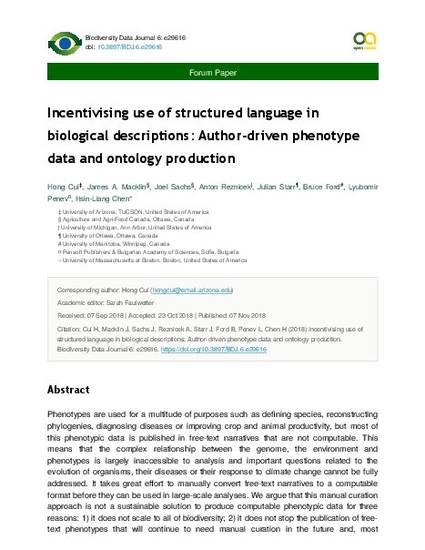
Phenotypes are used for a multitude of purposes such as defining species, reconstructing phylogenies, diagnosing diseases or improving crop and animal productivity, but most of this phenotypic data is published in free-text narratives that are not computable. This means that the complex relationship between the genome, the environment and phenotypes is largely inaccessible to analysis and important questions related to the evolution of organisms, their diseases or their response to climate change cannot be fully addressed. It takes great effort to manually convert free-text narratives to a computable format before they can be used in large-scale analyses. We argue that this manual curation approach is not a sustainable solution to produce computable phenotypic data for three reasons: 1) it does not scale to all of biodiversity; 2) it does not stop the publication of free-text phenotypes that will continue to need manual curation in the future and, most importantly, 3) It does not solve the problem of inter-curator variation (curators interpret/convert a phenotype differently from each other). Our empirical studies have shown that inter-curator variation is as high as 40% even within a single project. With this level of variation, it is difficult to imagine that data integrated from multiple curation projects can be of high quality. The key causes of this variation have been identified as semantic vagueness in original phenotype descriptions and difficulties in using standardised vocabularies (ontologies). We argue that the authors describing phenotypes are the key to the solution. Given the right tools and appropriate attribution, the authors should be in charge of developing a project’s semantics and ontology. This will speed up ontology development and improve the semantic clarity of phenotype descriptions from the moment of publication. A proof of concept project on this idea was funded by NSF ABI in July 2017. We seek readers input or critique of the proposed approaches to help achieve community-based computable phenotype data production in the near future. Results from this project will be accessible through https://biosemantics.github.io/author-driven-production.
- Controlled Vocabulary,
- Computable Phenotype Data,
- Data Quality,
- Phenotype Ontologies
Available at: http://works.bepress.com/hsin-liang-oliver-chen/65/
